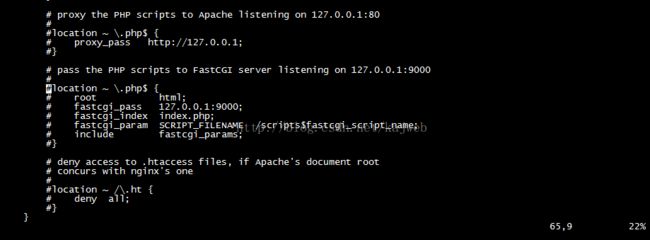利用C语言制作网站
进入终端后,我们先尝试ls命令
ls
ls命令,是显示目录内的文件,类似CMD中的dir。和powershell中的ls类似。
如果没有nginx-1.6.0.sh这份文件,我们可以运行一下VIM把下面的文件保存为nginx-1.6.0.sh
#!/bin/bash
SRC_URI="http://t-down.oss-cn-hangzhou.aliyuncs.com/nginx-1.6.0.tar.gz"
PKG_NAME=`basename $SRC_URI`
PKG_NAME_DIR=nginx-1.6.0
PREFIX=/alidata/nginx
LOGS=$PREFIX/logs
VHOSTS=$PREFIX/conf/vhosts
DIR=`pwd`
DATE=`date +%Y%m%d%H%M%S`
CPU_NUM=$(cat /proc/cpuinfo | grep processor | wc -l)
\mv $PREFIX ${PREFIX}.bak.$DATE &> /dev/null
mkdir -p $PREFIX
mkdir -p $VHOSTS
mkdir -p /alidata/install
####---- user add ----begin####
groupadd www &> /dev/null
useradd -g www -M -d /alidata/www -s /sbin/nologin www &> /dev/null
####---- user add ----end####
cd /alidata/install
if [ ! -s $PKG_NAME ]; then
wget -c $SRC_URI
fi
####---- install dependencies ----begin####
if [ "$(cat /proc/version | grep redhat)" != "" ];then
wget http://git.jiagouyun.com/operation/operation/raw/master/linux/redhat/CentOS-Base.repo -O /etc/yum.repos.d/CentOS-Base.repo
yum makecache
yum -y install gcc gcc-c++ gcc-g77 make unzip automake openssl openssl-devel curl curl-devel pcre-devel
elif [ "$(cat /proc/version | grep centos)" != "" ];then
#note : The CentOS 5 series, Yum will install 32 bit packet, then filter out 32.
if [ `uname -m` == "x86_64" ];then
if cat /etc/issue |grep "5\." &> /dev/null;then
if ! cat /etc/yum.conf |grep "exclude=\*\.i?86" &> /dev/null;then
sed -i 's;\[main\];\[main\]\nexclude=*.i?86;' /etc/yum.conf
fi
rpm --import /etc/pki/rpm-gpg/RPM*
fi
fi
yum makecache
yum -y install gcc gcc-c++ gcc-g77 make unzip automake openssl openssl-devel curl curl-devel pcre-devel
elif [ "$(cat /proc/version | grep ubuntu)" != "" ];then
sed -i 's/exit 0//' /etc/rc.local
apt-get -y update
apt-get -y install unzip libcurl4-openssl-dev libpcre3-dev
elif [ "$(cat /proc/version | grep -i debian)" != "" ];then
apt-get -y update
apt-get -y install unzip libcurl4-openssl-dev libpcre3-dev
fi
####---- install dependencies ----end####
######----- install ----begin######
rm -rf $PKG_NAME_DIR
tar zxvf $PKG_NAME
cd $PKG_NAME_DIR
./configure --user=www \
--group=www \
--prefix=$PREFIX \
--with-http_stub_status_module \
--without-http-cache \
--with-http_ssl_module \
--with-http_gzip_static_module
if [ $CPU_NUM -gt 1 ];then
make -j$CPU_NUM
else
make
fi
make install
######---- install ----end######
cat > $PREFIX/conf/nginx.conf << EOF
user www www;
worker_processes 2;
error_log $LOGS/error.log crit;
pid $LOGS/nginx.pid;
#Specifies the value for maximum file descriptors that can be opened by this process.
worker_rlimit_nofile 65535;
events
{
use epoll;
worker_connections 65535;
}
http {
include mime.types;
default_type application/octet-stream;
#charset gb2312;
server_names_hash_bucket_size 128;
client_header_buffer_size 32k;
large_client_header_buffers 4 32k;
client_max_body_size 8m;
sendfile on;
tcp_nopush on;
keepalive_timeout 60;
tcp_nodelay on;
fastcgi_connect_timeout 300;
fastcgi_send_timeout 300;
fastcgi_read_timeout 300;
fastcgi_buffer_size 64k;
fastcgi_buffers 4 64k;
fastcgi_busy_buffers_size 128k;
fastcgi_temp_file_write_size 128k;
gzip on;
gzip_min_length 1k;
gzip_buffers 4 16k;
gzip_http_version 1.0;
gzip_comp_level 2;
gzip_types text/plain application/x-javascript text/css application/xml;
gzip_vary on;
#limit_zone crawler \$binary_remote_addr 10m;
log_format main '\$remote_addr - \$remote_user [\$time_local] "\$request" '
'\$status \$body_bytes_sent "\$http_referer" '
'"\$http_user_agent" "\$http_x_forwarded_for"';
include $VHOSTS/*.conf;
}
EOF
mkdir -p /alidata/www/default
echo 'Welcome to nginx! Welcome to nginx!
>>####
#location ~ .*\.(php|php5)?$
#{
# fastcgi_pass 127.0.0.1:9000;
# fastcgi_index index.php;
# include fastcgi.conf;
#}
####<<>>####
#location / {
#or : location ~ \.jsp\$ {
# proxy_pass http://server:8080;
# proxy_set_header Host \$host;
# proxy_set_header X-Real-IP \$remote_addr;
# proxy_set_header X-Forwarded-For \$proxy_add_x_forwarded_for;
#}
####<<>>####
location ~ .*\.(gif|jpg|jpeg|png|bmp|swf)$
{
expires 1d;
}
location ~ .*\.(js|css)?$
{
expires 1d;
}
####<<>>####
access_log $LOGS/default.log;
}
EOF
echo '#!/bin/bash' >> /etc/init.d/nginx
cat > /etc/init.d/nginx << EOF
# nginx Startup script for the Nginx HTTP Server
# this script create it by ruijie. at 2014.02.26
# if you find any errors on this scripts,please contact ruijie.
# and send mail to ruijie at gmail dot com.
# [email protected]
nginxd=$PREFIX/sbin/nginx
nginx_config=$PREFIX/conf/nginx.conf
nginx_pid=$PREFIX/logs/nginx.pid
RETVAL=0
prog="nginx"
[ -x \$nginxd ] || exit 0
# Start nginx daemons functions.
start() {
if [ -e \$nginx_pid ] && netstat -tunpl | grep nginx &> /dev/null;then
echo "nginx already running...."
exit 1
fi
echo -n \$"Starting \$prog!"
\$nginxd -c \${nginx_config}
RETVAL=\$?
echo
[ \$RETVAL = 0 ] && touch /var/lock/nginx
return \$RETVAL
}
# Stop nginx daemons functions.
stop() {
echo -n \$"Stopping \$prog!"
\$nginxd -s stop
RETVAL=\$?
echo
[ \$RETVAL = 0 ] && rm -f /var/lock/nginx
}
# reload nginx service functions.
reload() {
echo -n \$"Reloading $prog!"
#kill -HUP \`cat \${nginx_pid}\`
\$nginxd -s reload
RETVAL=\$?
echo
}
# See how we were called.
case "\$1" in
start)
start
;;
stop)
stop
;;
reload)
reload
;;
restart)
stop
start
;;
*)
echo \$"Usage: $prog {start|stop|restart|reload|help}"
exit 1
esac
exit \$RETVAL
EOF
chmod 755 /etc/init.d/nginx
chown -R www:www $LOGS
chmod -R 775 /alidata/www
chown -R www:www /alidata/www
cd ..
sed -i 's/worker_processes 2/worker_processes '"$CPU_NUM"'/' $PREFIX/conf/nginx.conf
chmod 755 $PREFIX/sbin/nginx
#add PATH
if ! cat /etc/profile | grep "export PATH=\$PATH:$PREFIX/sbin" &> /dev/null;then
echo "export PATH=\$PATH:$PREFIX/sbin" >> /etc/profile
fi
source /etc/profile
#add rc.local
if ! cat /etc/rc.local | grep "/etc/init.d/nginx start" &> /dev/null;then
echo "/etc/init.d/nginx start" >> /etc/rc.local
fi
/etc/init.d/nginx start
cd $DIR
bash
#include "fcgi_stdio.h"
#include
#include
int main()
{
while(FCGI_Accept() >= 0)
{
printf("Content-type: text/*\r\n\r\n");
printf("欢迎来到由阿里云运行的C语言");
}
return 0;
} 按下ESC退出编辑模式,输入
:wq
保存及退出VIM
编译这个文件
g++ a.cpp -o index.aliC -lfcgi
等待完成后,我们就可以去编译我们的C语言了
接下来,把文件替换一下,因aliyun是经过优化的,我们需要他原来的那份默认配置编辑
\cp -rf /alidata/nginx/conf/nginx.conf.default /alidata/nginx/conf/nginx.conf
运行VIM编辑文件并定位到第65行
vim /alidata/nginx/conf/nginx.conf +65
轻轻按下ctrl+v,进入编辑模式
按j选中我们要修改代码的注释
然后再按D删除注释
选到第65行,按i进入编辑模式把php改为aliC
同时,找到第66,68,69,70行可以删除,不删也没关系。
按下ESC然后输入:wq保存及退出
:wq
最后重启nginx
nginx -s reload
或者
killall nginx
nginx
最后,运行一下
spawn-fcgi -f /alidata/www/default/index.aliC -p 9000
看到如下提示证明成功了
接下来运行浏览器,打开http://localhost/index.aliC,或者执行
curl http://localhost/index.aliC
或者
curl http://127.0.0.1/index.aliC
即可看到如下结果
遇到的问题及解决方案
曾经遇到spawn-fcgi返回child exited with: 0的问题,经过搜索,解决方案很少,几乎找不到。
经过排查,发现是C的源码问题。需要加上
while(FCGI_Accept() >= 0) 



